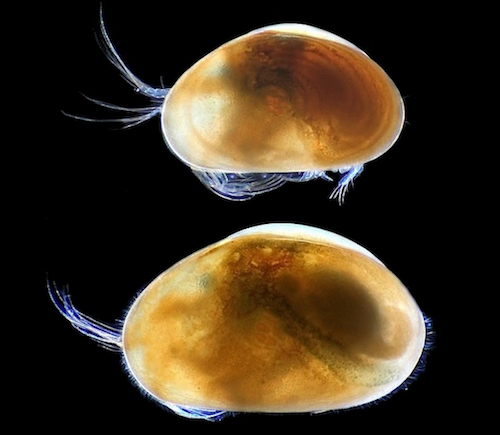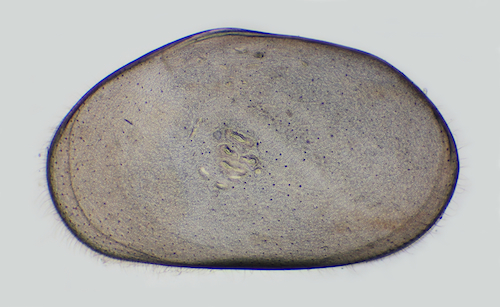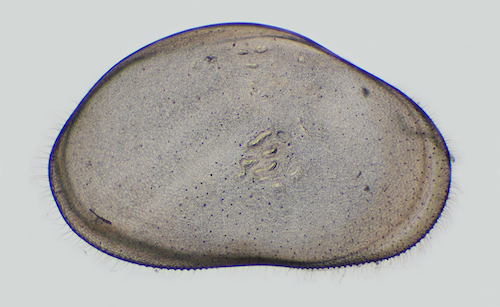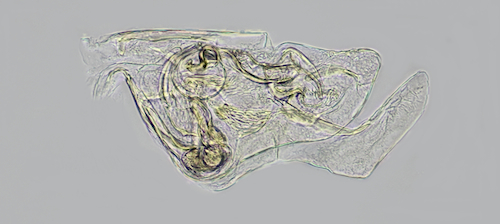
Genus Cyprinotus Brady, 1866
Superfamily: Cypridoidea Baird, 1845
Family: Cyprididae Baird, 1845
Subfamily: Cyprinotinae Bronstein, 1947
Two species have been reported from Japan:
1. Cyprinotus kimberleyensis McKenzie, 1966
- Figures in: McKenzie 1966; Okubo 1974; Okubo 2004.
- Habitat: Rice fields (Okubo 1974; 1990; 2004), swamp (Okubo 1974); muddy field (Broodbakker 1988).
- Mode of life: Nektobenthic (swimmer).
- Reproduction mode: Asexual. Males unknown.
- Known distribution: Okayama Prefecture (Okubo 1974; Okubo 1990 as Cyprinotus setoensis); Central Shikoku Island (Okubo 2004); Okinawa (Broodbakker 1988; Okubo 2004). Elsewhere, China, Taiwan (Yu et al. 2009, citing grey literature); North-western Australia (McKenzie 1966).
- References:
- ⚬ Broodbakker, N. W. 1988. Ecology and distribution of groundwater Crustacea and freshwater Ostracoda in SW Honshu and the Nansei Islands, Japan. Verlagen en Technische Gegevens Institute voor Taxonomische Zoologie, 53, 1-21.
- ⚬ McKenzie, K. G. 1966. Freshwater Ostracoda from North-western Australia. Australian Journal of Marine and Freshwater Research, 17, 259-279.
- ⚬ Okubo, I. 1974 a. Two species of the genus Cyprinotus (Ostracoda, Cyprididae) from Japan. Researches on Crustacea, 6, 58-70.
- ⚬ Okubo, I. 1990a. Seven new species of freshwater Ostracoda from Japan. Researches on Crustacea, 19, 1-12.
- ⚬ Okubo, I. 2004. Nihon tansui san kaimijinko rui ni tsuite. Kabushikigaisha Sanmon Insatsusho, Okayama, Japan, 72pp. [In Japanese, privately published].
- ⚬ Yu, N., Zhao, Q., Li, E., Chen, S. & Chen, L. 2009. An updated and annotated checklist of recent nonmarine ostracods from China. Zootaxa, 2067, 29-50.
2. Cyprinotus cassidula Smith & Chang, 2020

Left side views of a male (top) and female Cyprinotus cassidula, male length 1.5 mm, female length 1.9 mm. Note how the right valve is higher than the left.

External view of female left valve, length 1911 microns.

External view of female right valve, length 1863 microns.

The male sexual organ of Cyprinotus uenoi, length 362 microns.
- Additional figures in: Okubo 1974 (as Cyprintous uenoi); Victor & Fernando 1981 (as Cyprintous uenoi); Okubo 2004 (as Cyprintous uenoi).
- Habitat: Often found in ricefields, especially abundant in the early rice-growing season in Japan. Also found in reservoirs and ponds.
- Mode of Life: Nektobenthic (swimmer).
- Reproduction mode: Sexual, males common.
- Distribution: Okayama Prefecture, Oita Prefecture (Okubo 1974, as C. uenoi), Gunma Prefecture (Okubo & Ida 1989, as C. uenoi), Yamaguchi Prefecture (Broodbakker 1988, as C. uenoi) and Shiga Prefecture (Smith & Chang 2020). Elsewhere, it has been reported from Korea (Kim & Min 1991, as C. uenoi; Chang et al. 2012, as C. uenoi; Smith & Chang 2020).
- References:
- ⚬ Broodbakker, N. W. 1988. Ecology and distribution of groundwater Crustacea and freshwater Ostracoda in SW Honshu and the Nansei Islands, Japan. Verlagen en Technische Gegevens Institute voor Taxonomische Zoologie, 53, 1-21.
- ⚬ Chang, C. Y., Lee, J. & Smith, R. J. 2012. Nonmarine ostracods (Crustacea) from South Korea, including a description of a new species of Tanycypris Triebel (Cyprididae, Cypricercinae). Zootaxa, 3161, 1 - 19.
- ⚬ Kim, W. & Min, G.S. 1991. Redescription of recent freshwater ostracods (Crustacea: Ostracoda) from Korea: A systematic study of four species of family Cyprididae. The Korean Journal of Systematic Zoology, 7, 81-100.
- ⚬ Okubo, I. 1974. Two species of the genus Cyprinotus (Ostracoda, Cyprididae) from Japan. Researches on Crustacea, 6, 58-70.
- ⚬ Okubo, I. and Ida, K. 1989. Freshwater Ostracoda from Gunma Prefecture, Japan. Bulletin of the Biogeographical Society of Japan, 44, 105-107. [In Japanese.]
- ⚬ Okubo, I. 2004. Nihon tansui san kaimijinko rui ni tsuite. Kabushikigaisha Sanmon Insatsusho, Okayama, Japan, 72pp. [In Japanese, privately published].
- ⚬ Smith, R. J. & Chang, C. Y. 2020. Taxonomic assessments of some Cyprinotinae Bronstein, 1947 species (Crustacea: Ostracoda) from Japanese and Korean rice fields, including (re-) descriptions of six species and a review of the type species of the subfamily. Zootaxa, 4795 (1), 001-069.